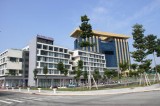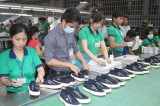Developmental reforms
Part 2: Resources gathered for development
Part 1: State-owned enterprises – locomotive economic development
To continue to take advantage of strengths and development, many State-owned enterprises in the area have decided to equitize. This is not only a testimony to the right policy of the government, Provincial Party Committee, and Provincial People's Committee, but also a solid foundation for state-owned enterprises to mobilize all resources in society, creating momentum for development.
Stability after equitization
Being one of the prominent economic units contributing to Binh Duong's socio-economic development, Phuoc Hoa Rubber Corporation (PHR) chose the right direction when deciding to equitize in February 2008. Since then, PHR has been firmly in the market thanks to good results of production and business operations, facing many difficulties.
Implementing the government's Decree No. 187/2004/ND-CP on the implementation of the policy on the equitization of state enterprises, on December 12, 2007, the Ministry of Agriculture and Rural Development issued Decision No. 399/QD-BNN-DMDN on the equitization of Phuoc Hoa Rubber Corporation. On February 28, 2008, the company held a shareholders' meeting to set up Phuoc Hoa Rubber Joint Stock Company, coded PHR in the stock market; the State holds controlling shares with the rate of 66.62% so far.

Equitization gathers resources for development and enable stability of the enterprises in the market. Photo: K. Vinh
At the time of 2008, the privatization of PHR was not only in line with the policy of the State but also considered as a right decision for the company. Thanks to early equitization, PHR has always had higher production and business norms year on year. The plantations have been expanded. The productivity of the plantations, labor productivity, average salary, and profit margin are constantly improving. The speed of development, efficiency of production and business operations have always been maintained highly and stably, preserving and developing the capital allocated by the State.
Good measures to manage product costs and control the unnecessary items in production to reduce cost price and increase profit have been implemented. Only in 2016, total pre-tax profit of the company reached VND 314.2 billion, gaining 156.6% of the plan. More encouragingly, the company paid a cash dividend of up to 18% of its profits. In addition, PHR has also paid the state budget more than VND 112 billion.
Thanks to the early equitization and non-stop application of scientific and technical progress, the average product price of PHR has usually been 2-3% higher than other companies in the past 3 years. This is attributed to high quality rubber products such as SVR CV50-60 accounting for 55% of total PHR products. Moreover, PHR is almost the only rubber company in the industry to consume plenty of CV50-60 rubber products thanks to the long-term and stable customer support.
Another optimistic piece of news is that PHR's stock income is still very high compared to other stocks on the exchange. After joining the stock market, PHR's annual dividend yield is stable at 10% per year. With the number of outstanding shares is 71.3 million, the total annual dividend cost is over VND 200 billion. Thus, investors in PHR shares can be assured with their cash flow.
PHR is the very first unit of the VRG to be certified of ISO 50001 by the Quacert Center. This proves that PHR's latex warfare process does not only reduce energy costs and emissions but also improve energy efficiency, contributing to energy efficiency and helping to use energy wisely.
Historic turn of Biconsi
Originated as a construction team under Department of Education and Training of Song Be province and established in 1980, Biconsi Binh Duong has made many breakthrough changes to firmly develop. The most significant sign was the decision to equitize the company in 2006 to develop into a multidisciplinary and multi-field company as today.
Founded in 1980, specializing in manufacturing school equipment, in 1993, the Team has been developed into a School Construction and Equipment Factory. In 2002, the People's Committee of Binh Duong Province issued Decision No. 81/2002/QD-UB dated June 17, 2002 on changing the name of School Construction and Equipment Factory into Binh Duong Construction & Investment Consultancy Company.
Binh Duong People's Committee issued Decision No. 699/QD-UBND dated 20 February 2006 approving the equitization plan and transforming the Binh Duong Construction & Investment Consultancy Company into Binh Duong Construction & Investment Consultancy Joint Stock Company (Biconsi). At that time, Biconsi encountered many difficulties initially with a chartered capital of only about VND 17 billion and the total turnover of equitization years of over VND 100 billion year on year. However, with great determination, Biconsi has grown and grown.
In the following years, the company financed its subsidiaries such as: Binh Duong General Import - Export - Import Corporation (Genimex), Thanh Phuoc Port Joint Stock Company (TPP), Building Materials Corporation (BMC), and Pétrus Ký Elementary & Secondary School. Up to date, the total charter capital of Biconsi and its subsidiaries has reached over VND 562 billion with total revenue in 2016 of VND 831 billion.
To achieve this success, Biconsi has overcome many challenges and difficultíe. Biconsi has step by step learned and done investigation to transit activities into the field of construction. It can be said that this is a historical change in the development of Biconsi. The period of 1993-2000, the boom of construction investment was incurred to increase the market demand for many types of construction. In such context, the company has put its first footprints in the construction market with its civil and infrastructure works for state agencies as well as a number of private projects such as Nguyen Van Cu Secondary School in Thu Dau Mot, Long Hoa - Dau Tieng Secondary School, Tan Binh Secondary School in Di An, Ben Cat District Health Center and so on.
In recent years, the land market has gradually been stabilized and land fund is not much. The company gradually shifts to strategies of engineering commercial centers and apartment buildings in favorable locations to provide high-grade apartments. Currently, the company cooperates with major brands such as CGV Cinema, California yoga & fitness, Co.opmart, Highland Coffee, Dai-ichi Life, Zakka Mart, etc. In addition, Biconsi has been building social housing projects to support staff, civil servants and low-income people who have the condition of owning apartment life.
Tran Huu Loi, Chairman and CEO of Biconsi said: "The company has gone through 10 years of equitization with various challenges. However, we have continually innovated and improved the quality to increasingly affirm our prestige in the market. Biconsi is proud to contribute to the dream of the Vietnamese people as well as to create teams of leaders and staffs full of expertise, experience and enthusiasm.”
It can be said that the decisions to equitize state-owned enterprises have been of the right policy of the government as well as Provincial Party Committee and People's Committee of Binh Duong province. The successful examples of equitization such as Phuoc Hoa Rubber Corporation and Biconsi are typical. The equitization of SOEs not only creates conditions for all economic sectors to have the opportunity to participate in production and business operations but also creates dynamic, innovative and ready notion to commit themselves to innovation, reach out for success in the marketplace.
Next: Part 3: Roadmap equitization
Reported by Khanh Vinh – Translated by Vi Bao
 Results of 7th provincial outstanding rural industrial products selection
Results of 7th provincial outstanding rural industrial products selection
 Lacquerware and ceramic products ready for Tet supplies
Lacquerware and ceramic products ready for Tet supplies
 To enhance investment attraction of industrial parks
To enhance investment attraction of industrial parks
 To remove obstacles tangling tax returns to enterprises and the people
To remove obstacles tangling tax returns to enterprises and the people
 Binh Duong strives to become a logistics center of the Southern region
Binh Duong strives to become a logistics center of the Southern region
 Real Estate Business Law 2023 raises high expectations to remove bottlenecks
Real Estate Business Law 2023 raises high expectations to remove bottlenecks
 Tan Uyen invests in transportation projects
Tan Uyen invests in transportation projects
 Practical support for enterprises ’sustainable development
Practical support for enterprises ’sustainable development
 Digital-based image and brand construction
Digital-based image and brand construction
 Support provided to facilitate social housing investment
Support provided to facilitate social housing investment











